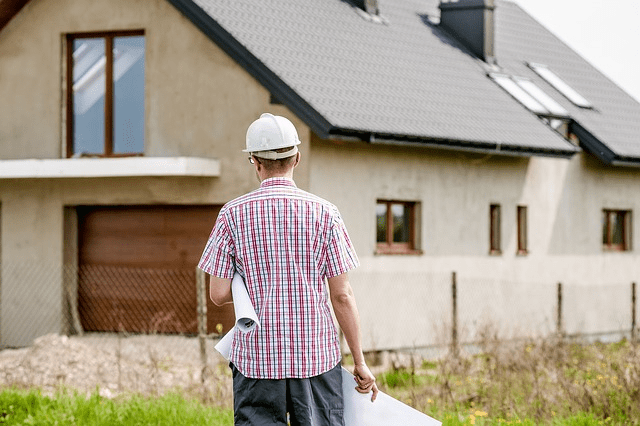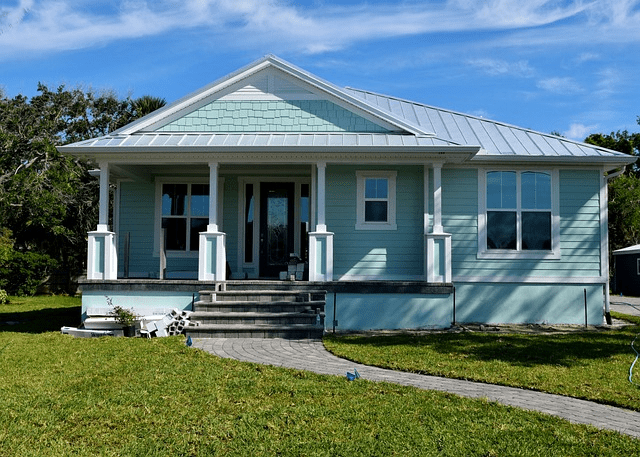A Quick Guide to Different Kinds of Termites
Termites are diverse insects with different types, each posing unique risks to structures. This article covers the main kinds of termites such as subterranean, drywood, and dampwood termites, and explains their behaviors and how they can affect your home.
Key Takeaways
The United States has approximately 45 different termite species, each presenting unique challenges for homeowners in terms of prevention and control.
Subterranean, Formosan, dampwood, drywood, and conehead termites are among the most common species in the U.S., each with distinct characteristics and nesting habits.
Effective termite prevention includes regular inspections, moisture control, and chemical treatments such as baiting systems to manage and reduce termite populations.
A Quick Guide to Different Kinds of Termites
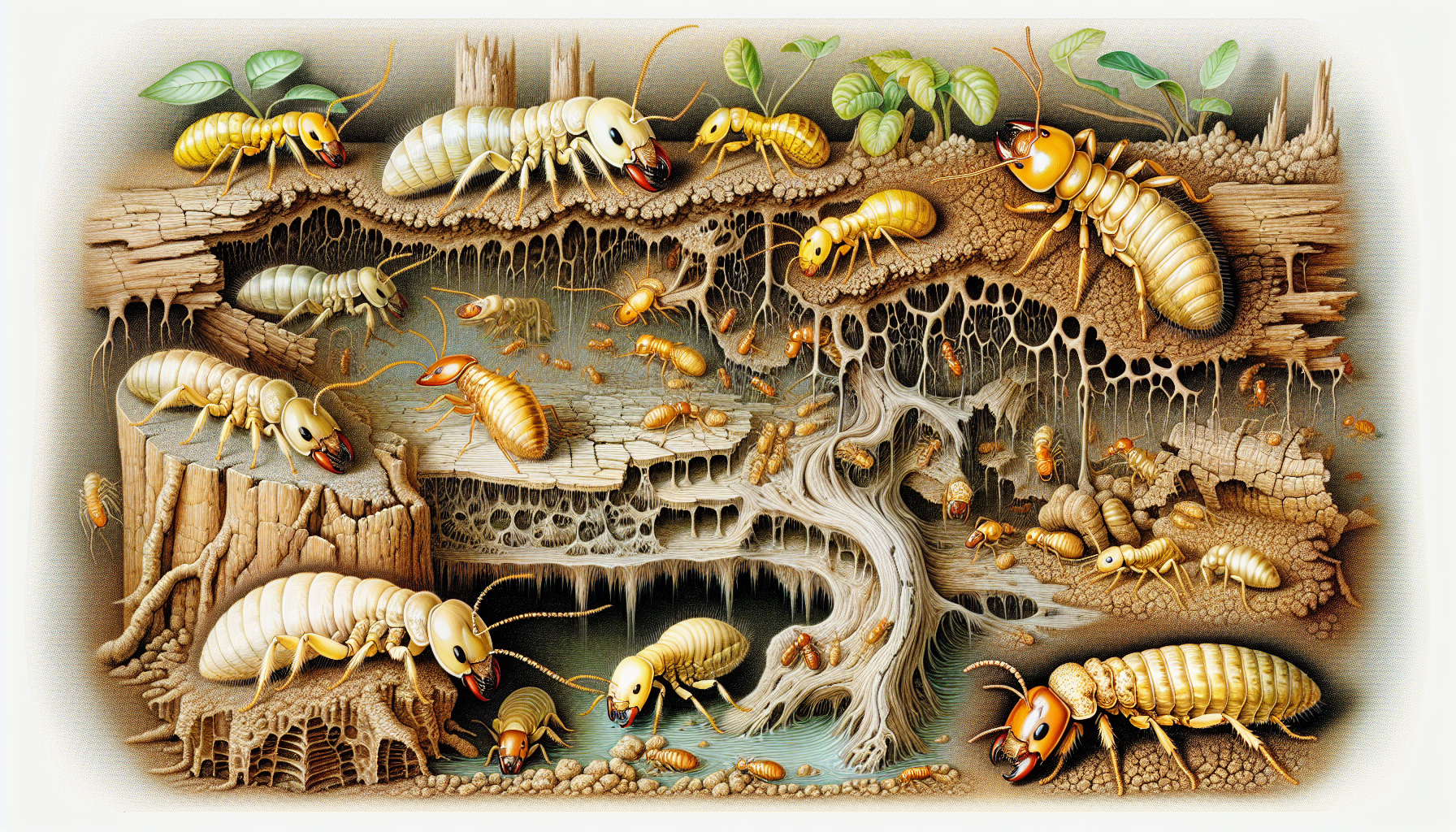
With approximately 2,972 known termite species across the globe, only a fraction have earned notoriety for their wood-chewing habits. In the United States alone, homeowners must contend with around 45 different types of termites, each with unique behaviors and appetites for destruction.
Destructive subterranean termites are infamous for their destructiveness, leading homeowners to struggle with hefty repair bills and extensive eradication measures. Being aware of the varying termite species, from the dampwood termites that thrive in humid conditions to the invasive conehead species, is crucial to safeguard your property against their relentless appetite.
Introduction
The story of termites is an ancient one, tracing back to their evolutionary roots shared with cockroaches. These wood-eaters evolved from a group of insects that includes wood-eating cockroaches, evidenced by similar symbiotic gut flagellates and morphological characteristics. Termites and the cockroach genus Cryptocercus are so closely related that they are considered a sister-group, a relationship that sheds light on their early divergence and subsequent specialization in wood consumption.
The name ‘termite’ itself, derived from the Latin ‘termes’, speaks to their woodworm nature and the silent, yet significant, impact they have on wooden structures.
Common Termite Species
When discussing termites in the United States, several species consistently emerge as the usual suspects in residential and commercial property damage. These include:
Eastern Subterranean Termites
Formosan Subterranean Termites
Drywood Termites
Dampwood Termites
Conehead Termites
Each species has adapted to specific environmental conditions and presents unique challenges in terms of prevention and control.
Subterranean Termites
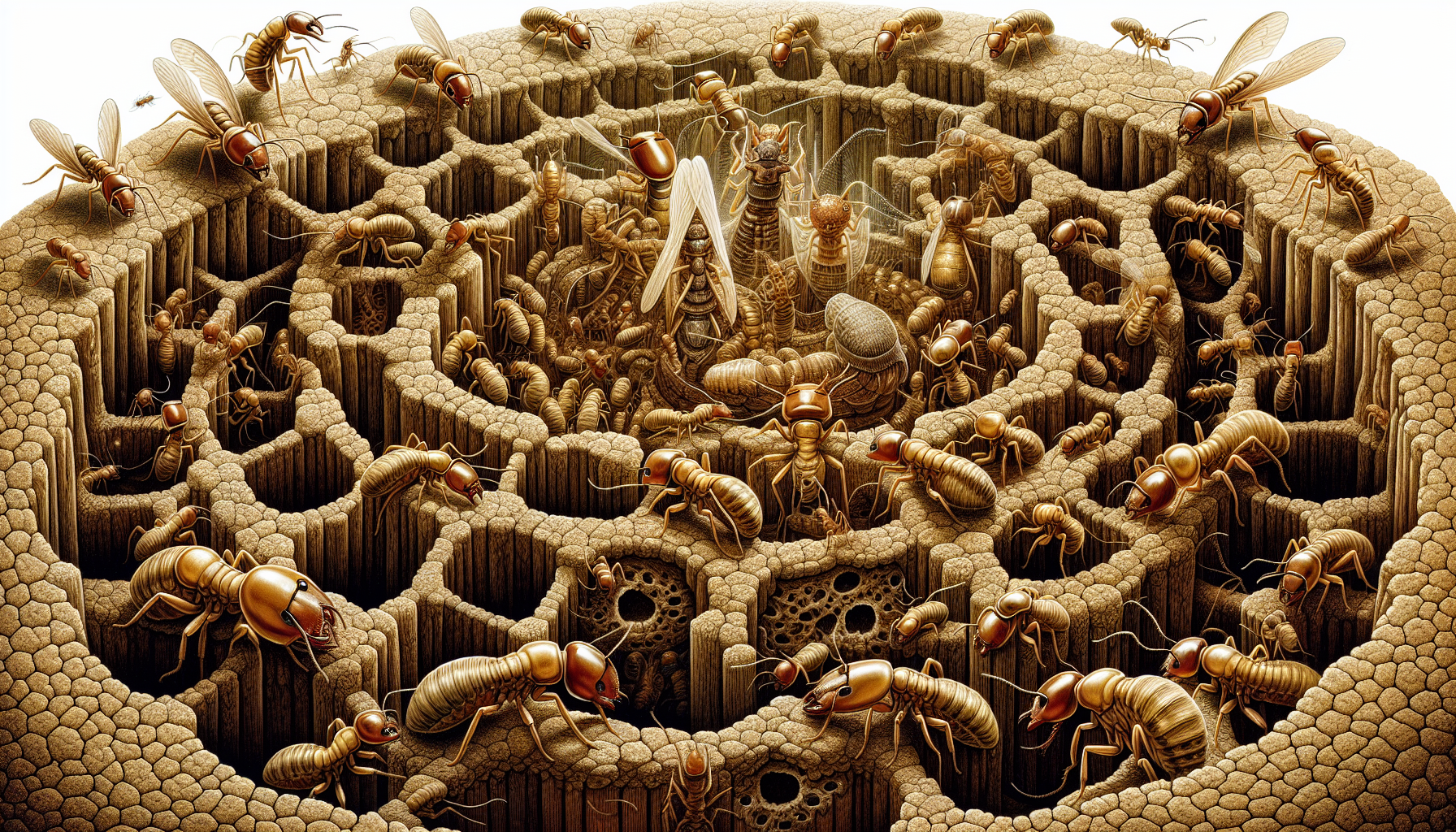
Beneath the surface of nearly every state except Alaska, subterranean termites forge their massive underground colonies. These insects are so adept at avoiding detection that they’ve earned the title of the worst termite species due to the extensive damage they inflict on wooden structures. With colonies that can amass up to 2 million members, they create elaborate tunnel systems extending over 100 meters from their nests, allowing them to access and decimate wood over large areas.
These insects’ extensive foraging territories and intricate social structures pose a significant challenge to property owners.
Formosan Termites
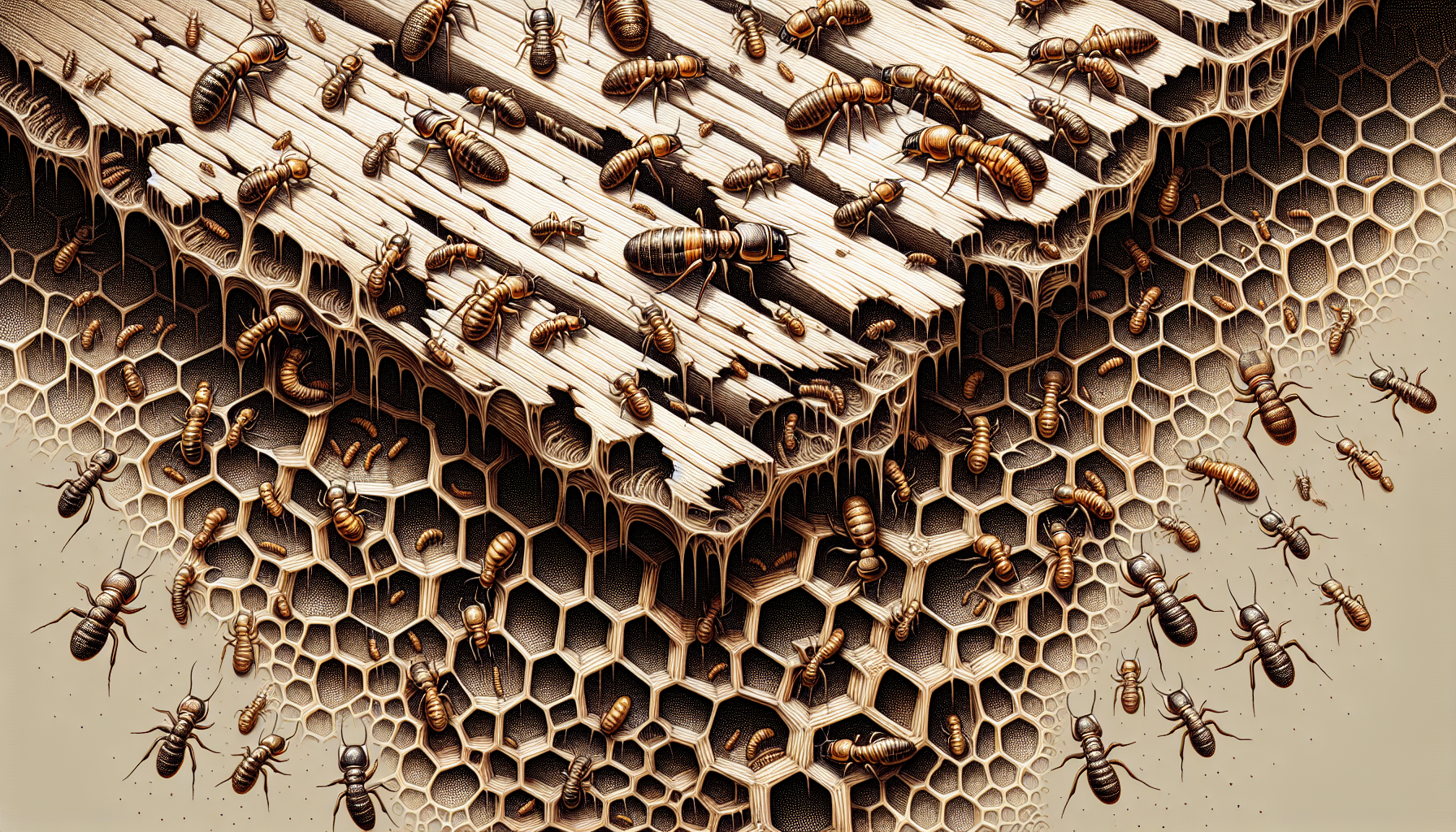
Known as ‘super termites’, subterranean and Formosan termites are an aggressive and invasive species with the capability to outdo and overrun native termite populations, including the formosan subterranean termite. Some key characteristics of Formosan termites are:
Their colonies are immense
They can build both subterranean and above-ground nests
Above-ground nests are known as cartons, which are made from a mix of soil, chewed wood, and saliva
Found primarily in the southern states, these termites are notorious for their ability to infest a structure to the point of being difficult to control.
Dampwood Termites
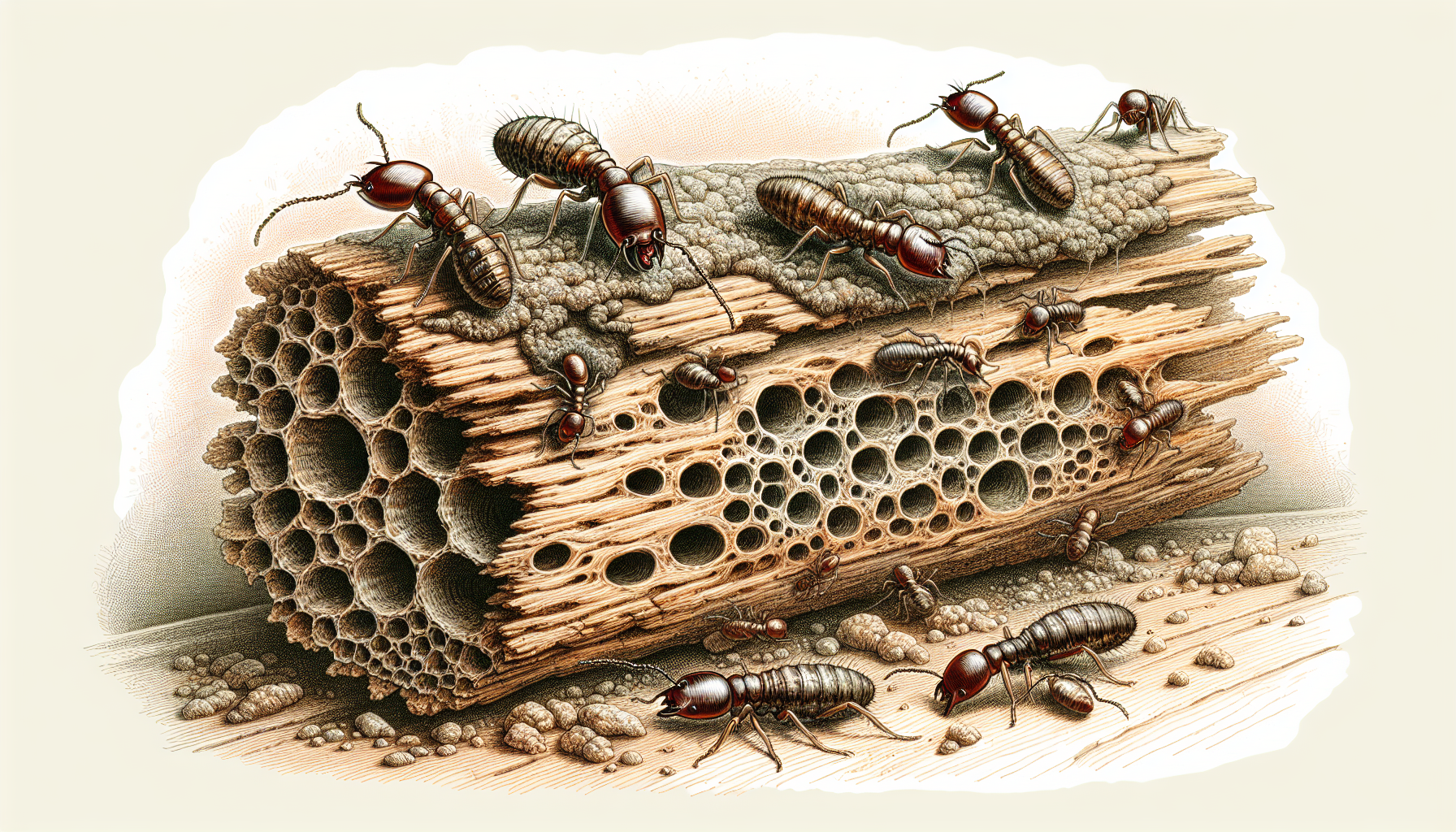
Dampwood termites thrive in moist environments, preferring to infest wood that has been softened by water. These termites, the giants among their kind, necessitate a high moisture level in the wood they feed on. They are particularly drawn to wood that is in direct contact with soil, such as fence posts and dead trees, setting them apart from other termite species that may require less moisture.
Drywood Termites
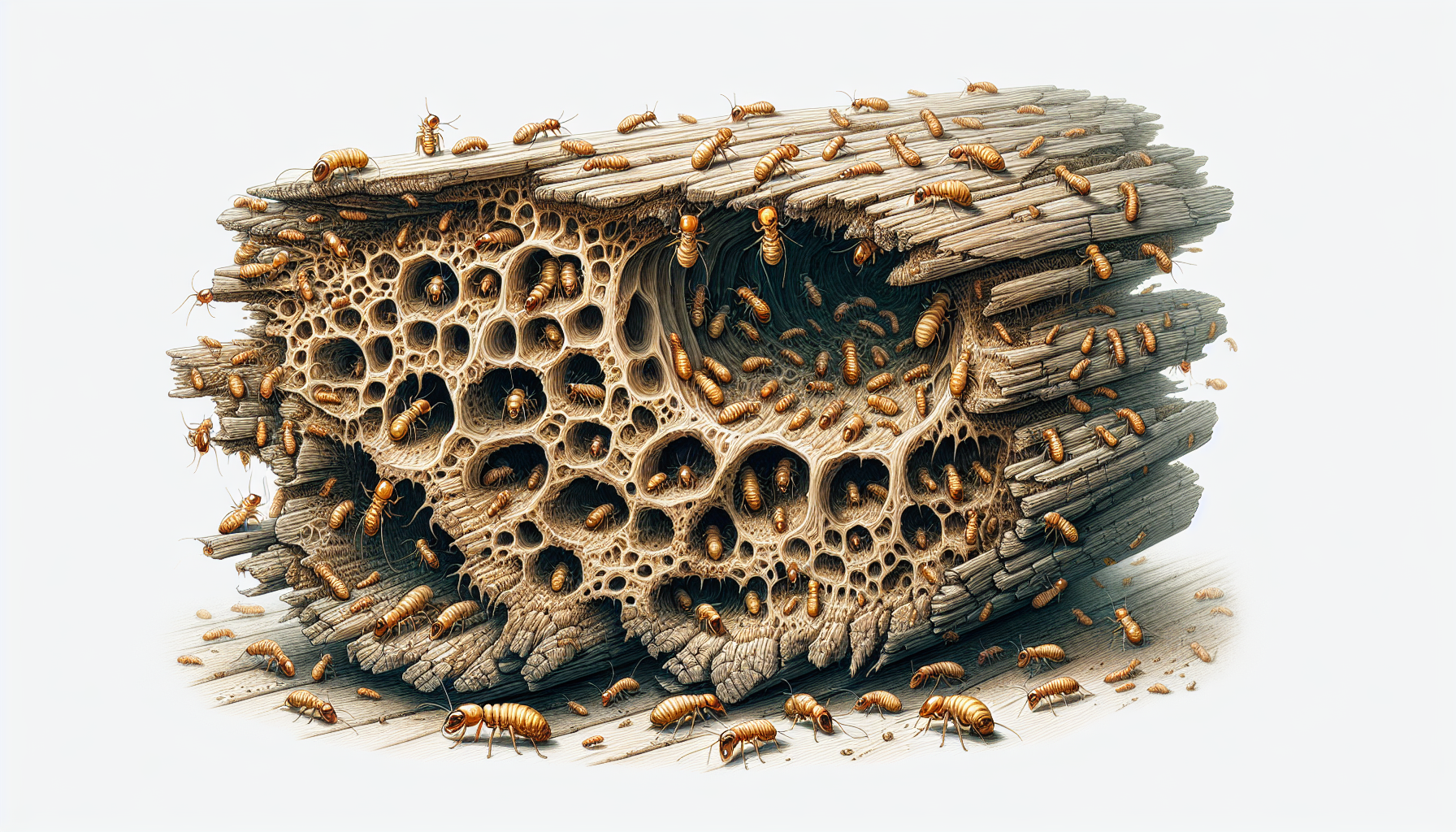
Unlike their subterranean and dampwood cousins, drywood termites do not require contact with the soil to survive. They can be found infesting dry wood, including structural timber, furniture, and hardwood floors, often in coastal states from North Carolina to California. Drywood termite colonies are smaller in size, but their ability to live within the wood they consume allows them to cause significant damage unnoticed.
Evidence of their presence can be found in the form of small piles of fecal pellets and complex tunnels they burrow through walls and furniture.
Conehead Termites
Conehead termites are notorious for the rapidity with which they can inflict property damage. Originating from the Caribbean, these termites:
Do not limit themselves to underground tunneling
Forage on the ground, much like ants
Are highly visible and aggressive in nature
Have the ability to inflict extensive damage within a brief time frame
This poses a significant threat to wooden structures, especially when dealing with dead wood or infested wood.
Identifying Termite Damage
Detecting the stealthy work of termites can be challenging, as they often remain hidden until significant damage has occurred. Nonetheless, timely detection is crucial in averting severe damage and the consequent steep repair expenses. Homeowners should be vigilant for signs like:
Discolored or drooping drywall
Peeling paint that mimics water damage
Hollow-sounding wood
Small holes in drywall
These signs all suggest termite activity.
Mud Tubes
One of the most definitive signs of a subterranean termite infestation is the presence of mud tubes. These constructions act as secure passageways, linking the termite colony to its feeding grounds while ensuring a safe transit that maintains their necessary humidity and darkness. Mud tubes can be found clinging to foundations or walls, their size varying from a quarter to an inch in diameter, and serve various purposes, including exploration and transport of food to the colony.
Damaged Wood
Termites’ insidious nature means they often leave behind a trail of destruction before they’re ever noticed. Wood damaged by termites often exhibits intricate patterns reflecting their feeding habits, visible in furniture, floorboards, or walls.
Drywood termites, in particular, are known for producing distinctive six-sided fecal pellets that can indicate their presence within a structure.
Discarded Wings
During swarming season, reproductive termites, known as alates, take flight to create new colonies. Following their flight, they discard their wings, leaving behind piles resembling fish scales, commonly found near the house’s foundation. These discarded wings can be easily confused with those of flying ants, making professional identification crucial to ensure the correct pest is being targeted.
The Life Cycle of Termites
The termite life cycle is intriguing, with each member of the colony fulfilling a designated role in its intricate social system. From the mating flight to the establishment of new colonies, termites undergo incomplete metamorphosis, experiencing multiple molts before reaching adulthood.
While a queen can lay an astonishing number of eggs daily in a mature colony, her lifespan can extend up to 50 years, making her a long-term pillar of the colony’s survival.
Reproductive Termites
The queen and king, the reproductive members of a termite colony, play a crucial role in its growth and perpetuation. The queen’s primary function is to lay eggs, with some species capable of laying tens of thousands each day.
Winged alates, which emerge from the colony during specific seasons, undertake mating flights to start new colonies, shedding their wings thereafter to become the kings and queens of their new domains.
Worker Termites
Tasked with maintaining the nest, foraging for food, and nurturing the young, worker termites serve as the tireless labor force of the colony. These wingless termites construct tunnels, move eggs, and groom the young, ensuring the entire colony functions smoothly. Their life span is much shorter than that of the queen, living only one to two years, but their role is critical to the colony’s survival.
Soldier Termites
Acting as the colony’s defenders, soldier termites are characterized by their enlarged heads and strong mandibles, designed for warding off predators. Their yellow-brown bodies stand out among the worker termites, and despite their formidable appearance, they rely on the workers to feed them due to their specialized mandibles.
Termite Nests and Habitats
Termites demonstrate their architectural skills through the diversity of nests they build, including subterranean, arboreal, and epigeal. Each type of nest is a marvel of natural engineering, providing shelter, climate control, and a place to rear offspring. The nests reflect the termites’ needs for food, moisture, and protection, often extending over a wide radius and featuring intricate designs for ventilation and strength.
Subterranean Nests
Subterranean termite nests, marvels of subterranean architecture, are constructed within the soil to uphold a consistent temperature and humidity that benefits both the termites and the fungi they cultivate. These nests are not just homes but fortresses, with the ability to withstand weather and resist predators, thanks to the termites’ unique biocement made from soil, water, and saliva.
Arboreal Nests
Arboreal nests, constructed by termites who prefer an elevated habitat, utilize materials from their verdant surroundings. These nests are designed to endure the elements and provide a safe haven from predators and environmental conditions, showcasing the versatility of termite nest-building.
Epigeal Nests
Also referred to as termite mounds, epigeal nests tower from the ground similar to natural skyscrapers in landscapes with optimal soil moisture. These above-ground structures are a mix of termite fecal matter, saliva, and mud, which are as durable as they are iconic.
In regions with hot climates, such as Africa and Australia, these mounds are a common sight, with internal chimneys that facilitate air circulation and temperature regulation, a testament to the termite’s ability to engineer a livable environment even in the harshest of conditions.
Prevention and Control Methods
Preventing and controlling termite infestations require a strategic approach, and while homeowners can take certain measures, professional services such as those offered by Imperial Pest Prevention are critical in ensuring effective management.
From understanding the behavior and biology of termites to employing the latest techniques in eradication, professionals can provide the knowledge and tools necessary for keeping these pests at bay.
Regular Inspections
Conducting regular inspections, preferably annually, is among the most effective strategies for termite prevention. These inspections can identify early signs of termite activity, allowing homeowners to take proactive steps before an infestation becomes well-established.
Professional inspectors are trained to spot potential entry points and conditions conducive to termite activity, providing recommendations to mitigate risks and maintain a termite-free home.
Moisture Control
Given that termites are drawn to moisture, controlling moisture levels is a critical part of termite prevention. Homeowners should ensure proper drainage around their property’s foundation, fix leaks promptly, and maintain a gap between soil and wooden parts of buildings to reduce the risk of attracting termites.
Additionally, keeping vents clear of blockages can help control moisture levels within the home, further deterring termite activity.
Chemical Treatments
Chemical treatments are crucial in the fight against termites. Baiting systems, for example, use poisoned bait to attract termites and systematically reduce the colony’s population. These baits contain cellulose laced with a slow-acting insecticide, ensuring that termites carry the poison back to their nest, effectively targeting the entire colony over time.
Summary
As we conclude our foray into the world of termites, it becomes evident that these small creatures pose a significant challenge to homeowners. Understanding the different species, their life cycles, habitats, and the signs of infestation are paramount in the fight against termite damage. Employing regular inspections, controlling moisture, and utilizing professional pest control services are key strategies in preventing these insects from becoming unwelcome guests in our homes.
Let this guide serve as the foundation for your vigilance against termites. Remember, the more you know about these industrious insects, the better equipped you’ll be to protect your property from their potentially devastating impact. Let’s not give termites any ground—stand informed and ready to act.
Frequently Asked Questions
What is the most damaging type of termite?
The most damaging type of termite in the U.S. is the subterranean termite, known for its destructive behavior. It is important to be vigilant about preventing and controlling these termites.
How can I tell if I have a termite infestation?
You can tell if you have a termite infestation by looking for signs like mud tubes on exterior walls, damaged wood that sounds hollow when tapped, small holes in drywall, and piles of discarded wings near windows or doors. Regular inspections can help detect these signs early.
What attracts termites to a property?
Termites are attracted to moisture, wood in contact with soil, and untreated lumber. Minimizing moisture and wood-to-soil contact can make your property less inviting to them. Be proactive in addressing these factors to prevent termite infestation.
Can termites be eradicated without professional help?
It’s usually necessary to hire professional pest control services for complete termite eradication, especially with aggressive species like Formosan termites. DIY methods may not be sufficient.
What is the difference between flying ants and termite swarmers?
The main difference between flying ants and termite swarmers is in their wings and waist. Termite swarmers have uniform wings and a straight waist, while flying ants have unevenly sized wings and a pinched waist. The presence of discarded termite wings also indicates termite activity.


